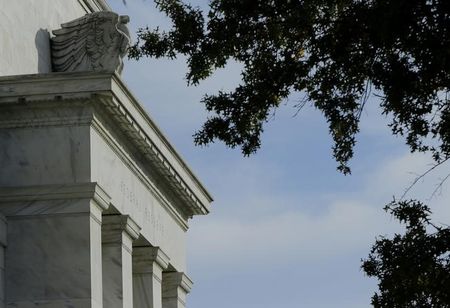By Jonathan Spicer and Ann Saphir
NEW YORK/SAN FRANCISCO (Reuters) - Tumbling oil prices have strengthened rather than weakened the Federal Reserve's resolve to start raising interest rates around midyear even as volatile markets and a softening U.S. inflation outlook made investors push back the timing of the "liftoff."
Interviews with senior Fed officials and advisors suggest they remain confident the U.S. economy will be ready for a modest policy tightening in the June-September period, while any subsequent rate hikes will probably be slow and depend on how markets will behave.
While they are hard-pressed to explain why bond yields have fallen so low, their confidence in the recovery stems in part from in-house analysis that shows falling oil prices are clearly positive for the U.S. economy.
Internal models also suggest that a decline in longer-term inflation expectations probably does not signal a loss of faith in the Fed's 2-percent inflation goal.
Instead, the models attribute much of the recent decline in market-based measures of inflation expectations to increased investor confidence that prices will not spiral out of control, officials say.
Policymakers' public comments reflect that, as they sound unperturbed by what has been a steep drop in recent months.
"I am watching the inflation expectation numbers but not drawing a conclusion that they call for any action or that they change in any serious way my outlook," Atlanta Fed President Dennis Lockhart told reporters earlier this week.
Some of those interviewed stressed that in the light of last year's strong jobs gains waiting until mid-year represented a cautious approach rather than an aggressive one, allowing the Fed to delay the rate liftoff if needed, particularly if inflation expectations turned sharply down.
However, with markets increasingly gripped by fears of global deflation and economic stagnation, futures traders now are betting the Fed will stay pat at least until October, possibly until December.
Yet interviews with the Fed insiders reveal that while they keep an eye on volatile markets they remain confident that unexpected overseas headwinds will not derail the U.S. economy.
CHEAP GAS BOOST
So far, signs of domestic price weakness, such as slow-growing wages, have not shaken the central bank's faith that inflation will rebound once energy markets stabilize, the interviews showed. In fact, cheaper gasoline and the boost it gives particularly to lower- and middle-income households could be just the shot of economic confidence the Fed needs to tighten policy after six years of near-zero rates.
"We've been through enough of these energy price swings...and this volatility can't go on forever," Richmond Fed President Jeffrey Lacker told Reuters in an interview Monday. "I don't think we'd have trouble looking through that transitory phenomenon," of slightly low inflation, and raise rates, he said. "I don't think we'd have trouble selling that."
Lacker has long criticized the Fed's exceptional monetary stimulus and advocated ending it, but his comments on inflation reflect the thinking of more centrist Fed policy makers on the subject.
A sharp drop in unemployment to 5.6 percent and solid economic growth have led most Fed policymakers to pencil in a rate rise this year, with many eyeing a move sometime in the summer. Most Wall Street economists agree with such timing.
Inflation remains a half-percentage point below the Fed's 2-percent target, and could slip more on plunging oil prices and the soaring dollar. But the Fed expects oil prices to eventually stabilize, the U.S. economy to keep growing despite weakness in Europe and elsewhere, and inflation to rebound in coming years.
The interviews also showed Fed officials were not overly alarmed by weakness in some market-based measures of inflation.
Some believe the sharp drop in longer-term borrowing costs, rather than a matter of concern, may be an added reason not to delay a tightening beyond mid-2015, especially if a "rush to safety" is driving demand for U.S. Treasuries.
With central banks in Europe and Japan looking to ease policy in the face of deflation threat, investors have sold stocks and commodities and snapped up U.S. debt, driving yields on 10-year and 30-year bonds to or near record lows.
Such low borrowing costs make for exceptionally easy financial conditions in the United States, even with the Fed looking to end the era of near-zero interest rates.
"I think it's important that the Fed not be so intent on every little movement in these asset market prices that they don't take strong enough action," said former Fed Vice Chairman Donald Kohn, who is now a member of the Bank of England's Financial Policy Committee. "I certainly expect them to be pretty cautious right after liftoff," he told Reuters.

The Fed took a small step toward its first rate rise in nearly a decade last month, when rather than saying it would wait a "considerable time" with tightening it said it would be "patient" - a term Fed Chair Janet Yellen suggested meant it might move in April at the earliest.